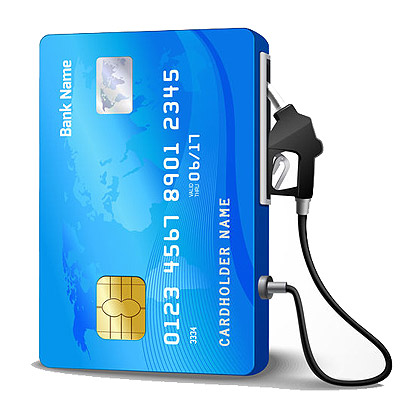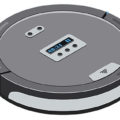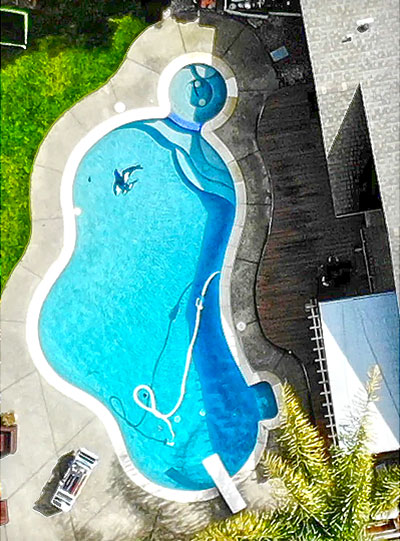
It’s true that pools are expensive to maintain, the equipment, water costs, chemicals, service people and more. Not to mention the time involved in regular upkeep and cleaning. With that said, a pool can actually be a more cost-effective alternative to owning a vacation property, a cottage or a cabin.
When you consider the overall costs, plus travelling it’s probably considerably cheaper. If you rent a vacation home every year, a pool could actually be an alternative option and your vacation funds could be redirected towards a dedicated pool budget!
For those who do choose to have a pool, or those lucky enough to have more than one, or all of the above recreation options available to them, here are some handy tips to help you save money maintaining your pool.
OPENING THE POOL YOURSELF
Most pools are very similar in their components unless you have a number of fancy water features and pumps, but they’re still not rocket science. It’s totally feasible to open your pool yourself and just takes a little bit of knowledge and effort. There are some great tutorials on how to open your pool that cover all of the basics. You can always call a pool company if you run into trouble.
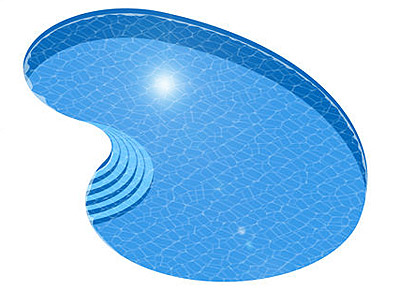
Try to drain your pool cover when the weather is sunny and the forecast looks dry! This will help the cover dry out and any remaining water evaporate, making it easier to get leaves off with a blower, and easier to pull the cover off of the water afterwards.
You’ll also want to open your pool earlier rather than later to make cleaning the water easier and quicker. The warmer the weather gets, the easier it is for algae to grow in untreated water. Because of this, it’s a good idea to open early in the season and close late in the fall.
If you get really lucky while opening, some of the spring showers may help you fill your pool and lighten that costly spring water bill!
PERFORM REGULAR MAINTENANCE
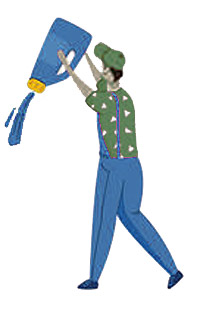
By trying to save a little you may end up spending a lot. It is much costlier to try and clear up an algae problem or dirty water by shocking or SLAMing your pool than it is to simply prevent it from happening in the first place with regular chlorine treatments. You will end up paying more for chemicals and spend more time cleaning than if you had just done the regular maintenance and testing. If you really don’t have the time, then it is probably cheaper to hire a company to maintain it for you as you’ll end up paying more either way.
Even worse, when your pool has a problem, regardless of who is maintaining it, you and your family will be losing valuable swimming time, particularly in colder climates where the swimming season is limited.
Pool stores will recommend shocking your pool once a week as well as using things like chlorine feeders and tablets to constantly release chemicals. Others believe it can be cheaper to simply be vigilant and regularly test and maintain the correct chemistry of your pool water.
TROUBLE FREE POOL
Knowing your pool and your water is half the battle in maintaining it. The Trouble Free Pool forum is one I would recommend for any assistance you need and general maintenance knowledge to help you save money on pool maintenance if you’re a DIY’er. I used it myself having no knowledge of pools at all initially, and the Shock Level And Maintain method along with a proper testing kit has worked well for me over the years and reduced having to buy a lot of expensive and unnecessary chemicals from the pool store.
STEER CLEAR OF THE POOL STORES AND UNNECESSARY CHEMICALS

Regular maintenance like the Trouble Free Pool method can keep you from buying overpriced shock products, algaecides, PH balancers or chlorine tablets. The only thing I really buy to maintain our pool is concentrated liquid chlorine in bulk and PH reducer (simply because it’s easier and more convenient than handling muriatic acid).
I’ve tried pool shock, 3-in-1 packs, trichlor, dichlor, chlorine tablets, 6% chlorine jugs… All the different products can definitely be both confusing and overwhelming. What I found to be the cheapest (although not the easiest for ease of maintenance for everyone) is 12% liquid chlorine. A 10 Litre jug runs about $8 and I’ll usually fill up about four at a time. These can last 3-4 weeks depending on various factors like weather, humidity, your pool pump and pool usage. About half a jug will shock my pool, which is about 1/3 cheaper than the packs of granular shock cost.
| Products | Prices | Size | Comments |
|---|---|---|---|
| Bioguard Smart Shock | $11 | 400 grams | Need 2 packs to shock and still requires a maintenance product (Silkguard sticks) |
| Chlorine Pucks | $1.45 / puck | $59.99 per 10 kg tub | An easy maintenance system put more expensive than liquid chlorine |
| 5 Litre Chlorine Jugs @ 6% | $5.49 / jug | $5.49 per 5 Litre jug | A cheaper option than granular or solid products, but more work. Appx. $1.10 / litre (@ 6%). |
| 10 Litre Chlorine Jugs @ 12S | $8.00 / jug | $8.00 per 10 Litre jug | More concentrated than 5L jugs. Appx $0.40 cents / litre (@ 6%) |
As you can see, if you have the time to monitor your chlorine levels and keep things in check, liquid chlorine can save you money. Also, be sure to check that your Cyanuric Acid (pool stabilizer) levels are appropriate and you are not losing chlorine too quickly. Check out Trouble Free Pool’s Pool School to learn more about pool maintenance.
BULK BUYING
Another way to save money on chemicals, maintenance products and testing kits is to buy during the off-season or at the end of the season. When you order in bulk or watch prices over the winter, you can score some great deals. Another method for savings is ordering products from the United States or to a U.S. address if they will not ship to Canada. Taylor test kit products and refills sold by third parties are available and much cheaper in the U.S. If you can buy them in the states or have them shipped to a U.S. address you can save a small fortune. You can also save by buying these items in bulk.
USE A SOLAR BLANKET TO COVER YOUR POOL
Solar Blankets cover your pool when you’re not using it and serve a few different purposes.
First of all, they help to keep the heat in your pool, especially when it gets into the colder months. You’ll save on heating costs as you won’t get as much heat escaping or water loss overnight. You’ll also benefit possibly from an extended swimming season, as once it gets really cold it either gets too difficult or too expensive to heat your pool.
Number two, solar blankets help save you money by saving water. Evaporation is a big cause of water loss in pools and having a cover over your pool will obviously help keep that water from evaporating into the air, along with your money! You’ll end up topping up your pool less frequently and also not having to heat all the new cold water you’re pouring in.
Thirdly, covering your pool during the daytime when not in use will help save you money on chlorine. The chlorine in your pool is broken down by the sun, so keeping it under wraps along with making sure stabilizer (CYA) levels are sufficient will help prolong its usefulness.
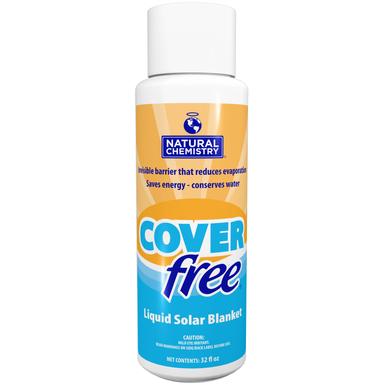
Solar covers are relatively inexpensive and will probably pay for themselves with proper care. One of the downsides is that they break down in the sun and many times will only last for two or three years. They can also be cumbersome to put on and take off the pool if you don’t have a roller. They can also be more awkward to handle if you have an irregular-shaped pool.
If you have an odd-shaped pool or just don’t want to deal with a solar cover, there are also “liquid solar blanket” products that claim to do the same thing as a physical solar blanket. They claim that the product does this by creating tension on the water surface and thus preventing evaporation. I forget the exact science behind it, but it sounded interesting enough that I decided to try it for $20 bucks.
Honestly, I’m not sure it did much, but at the same time, I don’t exactly have a controlled test environment to make that determination. If there was s difference or savings from using it, it wasn’t blatantly obvious.
GET A VARIABLE SPEED PUMP OR USE A TIMER TO SAVE ON ELECTRICITY
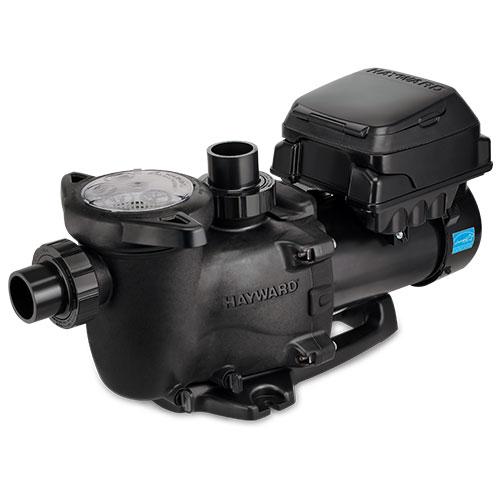
It is recommended to have your pool water turned over completely at least once a day. Meaning your pump will flow through the total number of gallons or litres in your pool, at least once in a 24-hour period. Most appropriately sized pumps can actually do this in 8 hours or less, so your pump doesn’t necessarily need to be running 24 hours a day. This is where a mechanical or electronic timer can help. Setting your pump on a timer can allow you to let it run for the time it needs to, but automatically shut off when it’s no longer required.
You may even want to try running it during the evening and overnight (off-peak) when electricity prices are cheaper. You do need to be cautious though and make sure you are maintaining your water quality. Depending on the outside temperatures, where you live and your pool water temperature it can be difficult to keep clean water if you are not running your pump during the daytime when the sun is out or when it is hottest. You have to play with your own setup and see what works best to balance cost savings with keeping the pool clean.
Another option is to install a variable speed pool pump, which can operate at lower RPMs and lower flow rates. The US Department of Energy produced a study that demonstrated significant savings using a variable speed pump. Where a regular pump needed to operate for just over 6 hours a day to turn a pool over, it operated at 2,000 Watts. A similar variable speed pump needed to operate for 19 hours to turn the water over at a lower flow rate. While the variable speed pump ran much longer daily, the savings however were impressive. Electricity usage was just 2.2kWh per day using a variable speed pump compared to 12.6 kWh per day with a single speed pump The chart below helps demonstrate these savings over the course of a swimming season and full year.
| Pump Type | Electricity Used / Hour | Hours Run | Electricity Used | Cost Per Day | Cost Per Year |
|---|---|---|---|---|---|
| Single Speed Pump | 2000 watts | 24 | 48 kWh | $5.76 | $2102.00 |
| Single Speed on Timer | 2000 watts | 6.3 | 12.6 kWh | $1.55 | $565.75 |
| Variable Speed Pump Full Day | 116 watts | 24 | 2.8 kWh | $0.67 | $244.55 |
| Variable Speed Pump 1 Turnover of pool | 116 watts | 19 | 2.2 kWh | $0.26 | $94.90 |
The results pretty much speak for themselves. While variable speed pumps are more expensive to purchase initially, there is a significant cost savings over the course of a single season. A variable speed pump will also likely run quieter since it’s operating at lower RPMs. When calculating your overall cost and savings you should take into account the season length in Canada to analyze how long it will take to recoup your investment on a more expensive, but more efficient variable speed pump. So while the cost savings over the course of a year look amazing, that data may only be relevant for 3-4 months in Canada.
CONSERVE WATER
Another one of the larger expenses involved in pool ownership is… water! Yes, water is relatively cheap, but filling a 20,000-gallon pool up throughout the season can add up. One of your best defences here is to conserve, conserve, conserve water!
So how can you go about saving that precious liquid from escaping your pool? First of all, prevent unnecessary splash-outs when swimming by not overfilling the pool to the point it’s spilling over the edges with every little wave. Try to keep kids and adults cannonballs and other big jumping and splashing to a minimum. I know, I know… the pool is supposed to be fun, so ignore this advice is completely understandable. But if you’re serious about water conservation, Dad can probably restrain from multiple cannonballs off the diving board.
One of the biggest ways to lose water in the hot summer months is evaporation. If you have a solar blanket, use it to cover your pool when not using it during the day. Make a habit of also covering it every night. Investing in a roller for your cover can make this job fairly painless. If you don’t have a cover or you have an odd-shaped pool. you can try a liquid solar cover to help keep water in your swimming pool. If you’re consistent with covering your pool, you should notice a lot less ‘topping up’ and your water bill should be lower.
Another big source of water loss is leaks in your pool or liner. Leaks aren’t always obvious, so it’s important to be able to assess your pool for leaks or have a professional do it. The cost to investigate may be minimal compared to all the water you end up losing over time.
Finally, a good way to conserve water is to make sure when you close your pool in the fall, not to drain too much water out unnecessarily. You generally want the water just below the pool jets, but I’ve seen lots of cases where the water gets drained well below, or the pool guys start running a pump and get busy doing something else and remove way too much. It may not seem or look like a lot of water at the time, but it could be an additional 3 or 4 hours of your hose running constantly in the spring to fill it back up.
CLOSE YOUR POOL YOURSELF OR DO A PARTIAL CLOSING
Just like you can open your pool fairly easily yourself, closing the pool isn’t too difficult either. Of course one of the major concerns on many people’s minds in colder climates is if you do something wrong you could end up with broken plumbing and pipes. This could end up costing a small fortune and not saving anything. If you’re unsure of what you’re doing, definitely have a professional close your pool.
If you’re not comfortable closing your pool and draining the lines, there is also the option to do some of the work yourself if you want to save some money. Lots of companies will offer partial closings, where they take care of winterizing your lines and putting the cover on, but you can take care of a lot of the other general maintenance tasks. These include things like removing ladders, vacuuming, skimming, draining etc. You can contact your local pool company to see if they offer partial opening or closing services, some even advertise it!
SAVE MONEY ON YOUR POOL THIS SEASON
Hopefully, you’ve found these tips helpful and they assist you not only in getting added enjoyment out of your pool this summer but also in saving some money in the process.
